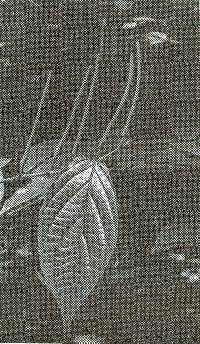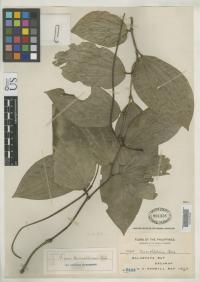
Neotropical Flora
|
Family: Piperaceae
[Lindeniopiper williamsii Trel., morePiper alluvicola C. DC., Piper hispidum var. magnifolium C. DC., Piper rivialbi Trel. & Yunck., Piper scabrum Sw.] |
Shrub, usually 3-6 m tall; stems inconspicuously hispid or glabrate in age basally, the trichomes moderately short, rigid, mostly directed outward or ascending, often more dense about the nodes, of varying lengths. Petioles usually 3-8 mm long; blades mostly elliptic to elliptic-ovate, acuminate, obliquely inequilateral, one side 2-5 mm shorter at base and mostly acute, the longer side usually obtuse to rounded at base, the blades mostly 8-20 cm long, 3.5-9 cm wide, drying very dark, pustular-scabrous above with longer stiff trichomes on veins, the lower surface usually with obscure glandular dots and with long straight trichomes mostly restricted to veins (remaining straight on drying), the intervenous areas glabrous or with shorter, less conspicuous trichomes (elsewhere in Panama with many long trichomes), the major lateral veins in 4-6 pairs, mostly in basal half. Spikes mucronate, mostly 9-12 cm long in fruit, ca 3 cm wide; peduncles usually 10 mm long; bracts triangular to round, sparsely short-ciliolate, the cilia shorter than width of bract. Fruits glandular-dotted, obovoid, +/- truncate and usually puberulent at apex; stigmas 3, minute, sessile. Croat 10191. The species is confused with P. dilatatum and P, culebranum, which are pubescent and have leaves of similar shape. Yuncker (1950) recognized two varieties of the species on BCI m addition to the typical variety. The variety trachydenna (Trel.) Yunck. differs in having the short stout trichomes on the upper internodes curved upward and more or less appressed. Considering the extreme variability in species of Piper, the character is hardly worthy of recognition. Range is uncertain, owing to the confusion in the taxonomy of this complex taxon. The species is described from the West Indies and probably occurs throughout the tropics of the Western Hemisphere. In Panama, known from tropical moist forest in the Canal Zone, Bocas del Toro, San Blas, Panama, and Darién, from premontane wet forest in Chiriqui and Coclé, and from lower montane wet forest in Chiriqui. Burger (1971) reported the species to be absent below 500 m elevation on the Pacific slope in Costa Rica. See Fig. 187. |
Powered by Symbiota.




























































